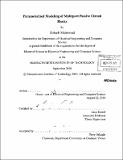Parameterized modeling of multiport passive circuit blocks
Author(s)
Mahmood, Zohaib
DownloadFull printable version (9.321Mb)
Other Contributors
Massachusetts Institute of Technology. Dept. of Electrical Engineering and Computer Science.
Advisor
Luca Daniel.
Terms of use
Metadata
Show full item recordAbstract
System level design optimization has recently started drawing the attention of circuit designers. A system level optimizer would search over the entire design space, adjusting the parameters of interest, for optimal performance metrics. These optimizers demand for the availability of parameterized compact dynamical models of all individual modules. The parameters may include geometrical parameters, such as width and spacing for an inductor or design parameters such as center frequency or characteristic impedance in case of distributed transmission line structures. The parameterized models of individual blocks need to be compact and passive since the optimizer would be solving differential equations (time domain integration or periodic steady state methods) to compute the performance metrics. Additionally, these parameterized models would be able to facilitate the job of the designer who could instantiate the models with different parameter value during manual optimization. In this thesis, we have designed and implemented various highly efficient algorithms for the identification of individual and parameterized models for multiport passive structures. The algorithms are based on convex relaxations of the original non-convex problem consisting of modeling multiport devices from frequency response data. Passivity is enforced in the final models by constrained fitting, where the constraints are either Linear Matrix Inequalities or semidefinite constraints. These individual non-parameterized models can be used for system level simulations for fixed parameter values or for building up a parameterized model. In the first algorithm, we identify a collection of first and second order networks to model individual non-parameterized passive blocks. Passivity of the overall model is guaranteed by enforcing passivity on the individual building blocks. In the second algorithm we exploit the property of causal and stable systems for which the real and imaginary parts of the frequency response are related by the Hilbert transform, by minimizing only the mismatch between real parts. Passivity is enforced in the identified model using semidefinte constraints. In this thesis we also propose an algorithm for generating parameterized multiport models of linear systems that the user will be able to instantiate for any parameter value, always obtaining a stable and passive model. Our approach uses constrained optimization to construct a parameterized model that optimally fits a set of given non-parameterized models using polynomial or rational basis. By using optimization, as opposed to interpolation as in the available parameterized modeling techniques, we are capable of guaranteeing global passivity with respect to the parameters, while simultaneously keeping the number of terms describing the model small. The proposed algorithms are supported by various modeling examples including Wilkinson combiners, power and ground distribution grid, on-chip coupled inductors, microstrip patch antenna and parameterized attenuator. The identified models are verified for passivity using the Hamiltonian matrix based eigenvalue test. Several comparisons with existing techniques are also provided, which demonstrate a promising speed up of 40x in some cases and an amazing efficiency, by generating a highly accurate model in the cases where alternative techniques even failed to generate the model.
Description
Thesis (S.M.)--Massachusetts Institute of Technology, Dept. of Electrical Engineering and Computer Science, 2010. Cataloged from PDF version of thesis. Includes bibliographical references (p. 97-99).
Date issued
2010Department
Massachusetts Institute of Technology. Department of Electrical Engineering and Computer SciencePublisher
Massachusetts Institute of Technology
Keywords
Electrical Engineering and Computer Science.